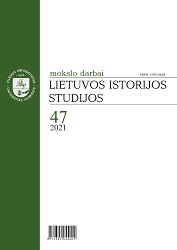Ką saugojo valstybė Vilniaus ir Naugarduko vaivadijose 1928–1939 metais? Kultūros paminklų vertinimas ir apskaita
What Was Protected by the State in Vilnius and Nowogródek Voivodeships Between 1928 and 1939? Evaluation and Listing of Cultural Monuments
Author(s): Viktorija KurienėSubject(s): Cultural history, Preservation, Local History / Microhistory, Political history, Interwar Period (1920 - 1939), Politics of History/Memory
Published by: Vilniaus Universiteto Leidykla
Keywords: interwar Poland; monuments conservator of Vilnius; monuments of the Vilnius voivodeship; monuments of the Nowogródek voivodeship; register of cultural monuments;
Summary/Abstract: This article focuses on the process of monument listing, done by conservators of Vilnius in interwar Poland and which provided the monuments state protection. Between 1931 and 1939, monument conservators made 202 decisions confirming monumental value to various objects of architecture, urbanistics, archeology and nature. In the text the listing and evaluation process is described by analyzing the register of monuments and the decisions it was based on. The documents from the archive of the Art Department of Vilnius voivodeship are used in the article. The analysis of the register of monuments is based on statistical methods. Interpretation and evaluation are based on analytical and comparative methods. The research leads to findings that monument listing was dominated by architecture. Objects of nature were announced monuments based on their cultural value. Officially the status of a monument was given on the grounds of its aesthetics, age or documental value. However, the inner motive was Polishness. Thus, the most frequent monuments were baroque Catholic churches. The patriotic context is also seen in nature protection. The process of monument listing was led by only one expert – a conservator of monuments. The monument status and state protection depended on their interests, expertise and power. The conservator cooperated onlywith a small group of Polish authority and intelligentsia, leaving the majority of society out of this heritage process. The decision confirming monumental value was a way to control and have an impact directly on the monument’s existence, indirectly – on the discourse of memory. The monument listing reveals values and identities of a Polish art historian working for the state. Consequently, these values and identities were projected for the whole society as universal. This type of discourse on heritage, conception and practice was common in Western countries in the 20th c.
Journal: Lietuvos istorijos studijos
- Issue Year: 2021
- Issue No: 47
- Page Range: 30-61
- Page Count: 32
- Language: Lithuanian

